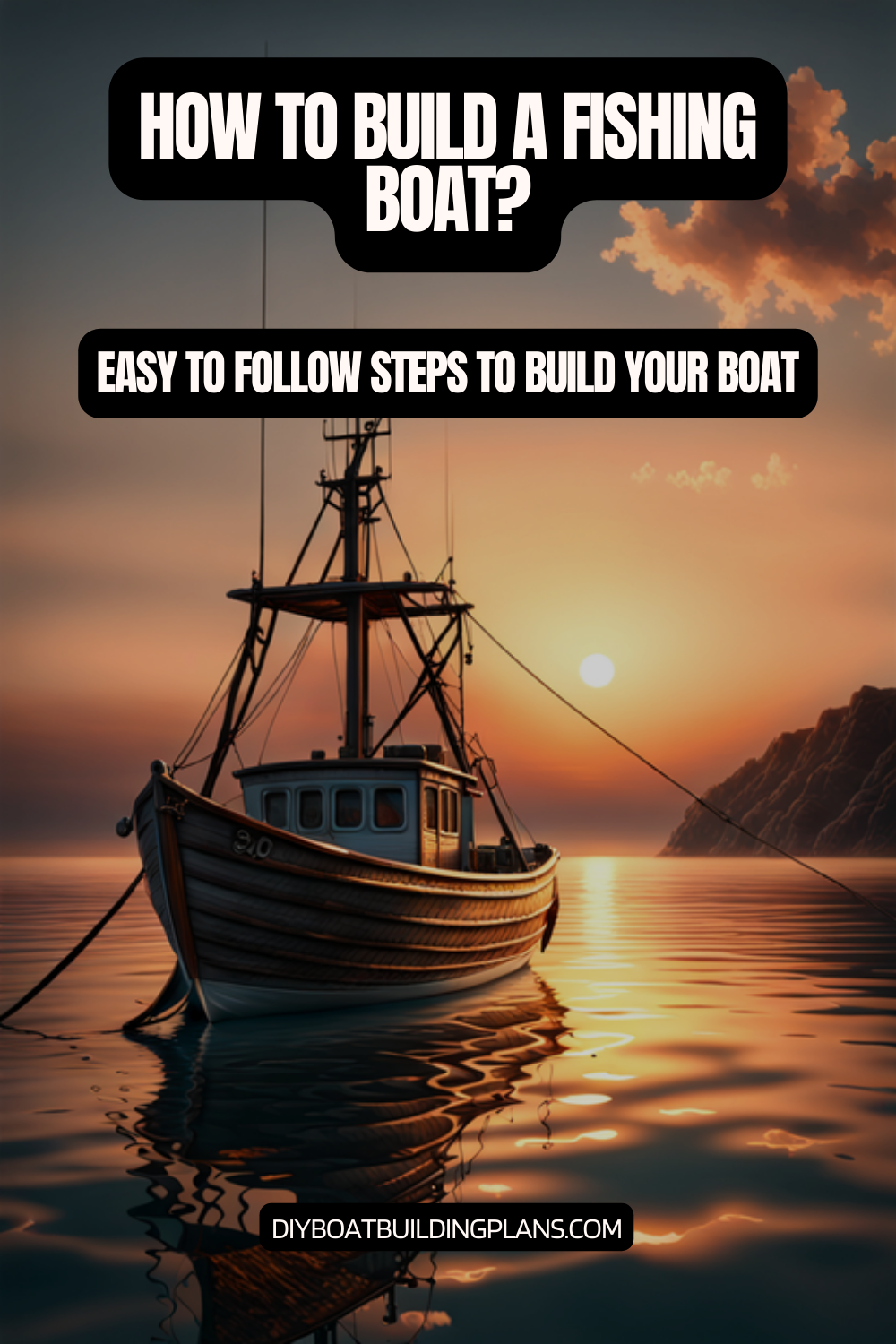Ever dreamed of making your own fishing boat? It’s not just a hobby. It’s a journey that turns you into a skilled boat builder.
Every year, thousands of fishing fans start their own boat-building projects. Online forums buzz with over 11,000 views and 13 active participants. The dream of a custom boat that fits your fishing style is strong.
Building a boat at home lets you turn basic aluminum boats into top-notch fishing machines. You can add casting platforms and advanced trolling motors. The possibilities are endless.
Key Takeaways – How To Build a Fishing Boat
- DIY boat construction offers complete customization of your fishing vessel
- Basic aluminum boats can be upgraded with professional modifications
- Home boat building requires careful planning and specific skills
- Customization can improve fishing efficiency and experience
- Building your own boat can be more cost-effective than purchasing

Understanding the Basics of Boat Building
Starting a boat building project needs careful planning and knowledge. Whether you’re into wooden boat plans or looking at different boatbuilding supplies, knowing the basics is key to success.
Types of Fishing Boats
Different fishing boats meet various needs and water conditions. Let’s look at the most popular ones:
- Aluminum Boats: Lightweight and durable
- Wooden Boats: Classic design with traditional appeal
- Fiberglass Boats: Smooth and low-maintenance
- PVC Boats: Affordable and versatile
Key Materials You’ll Need
Choosing the right materials is vital for building a successful boat. Boat construction videos often point out these essential materials:
| Material | Cost Range | Best For |
|---|---|---|
| Plywood | $200-$300 | Budget-friendly DIY projects |
| Fiberglass | $300-$500 | Smooth, durable finish |
| PVC | $100-$600 | Lightweight boats |
Required Tools and Equipment
Having the right tools makes boat building easier and more fun:
- Power drill
- Saber saw
- Belt sander
- Hack saw
- Measuring tape
“The success of your boat depends not just on materials, but on the precision of your tools and techniques.” – Professional Boat Builder
Take time to research wooden boat plans and watch boat construction videos. This will give you insights into the craft. Paying attention to detail will help you create a vessel that’s both functional and beautiful.
Setting Your Goals and Budget
Starting an affordable boating project needs careful planning. DIY boat construction lets you create a custom watercraft while keeping costs low.
Defining Your Boat’s Purpose
Know what you need before building your boat. Your boat’s purpose affects its design and budget. Think about these important points:
- Fishing environment (lakes, rivers, coastal waters)
- Passenger capacity requirements
- Storage needs
- Preferred fishing style
“A well-planned boat starts with a clear vision of its intended use.”
Estimating Your Budget
Building a boat yourself can save money compared to buying one. The cost depends on several things:
- Material costs
- Tool acquisition
- Potential upgrade expenses
- Long-term maintenance
DIY boating is great because you can pay for it over time. You can build your boat piece by piece, reducing financial strain and allowing for gradual investment.
Building a boat can cost between $400-$1,500, depending on size and complexity. Look for local deals, compare prices, and buy used tools to save money.
Designing Your Fishing Boat
Creating the perfect fishing boat begins with a solid design plan. Boat design drawings and wooden boat plans are key steps for DIY builders. The right design affects your boat’s performance, stability, and function.
- Hull shape and dimensions
- Intended fishing environment
- Personal skill level
- Budget constraints
Sketching Your Design
Start by making detailed sketches. Naval architects suggest using graph paper or boat design software for precise dimensions. Accuracy is key in turning your vision into a working boat.
“A well-planned design is half the battle in successful boat building” – Professional Boat Builder
Choosing the Right Dimensions
Choosing the right boat size is important. A 26×9 hull with a 22-degree deadrise at the stern is popular. It offers great stability and performance for fishing.
| Dimension | Recommended Size |
|---|---|
| Length | 26 feet |
| Width | 9 feet |
| Stern Deadrise | 22 degrees |
When making wooden boat plans, think about:
- Expected passenger capacity
- Intended fishing locations
- Engine requirements
- Storage and comfort needs
Professional builders suggest getting advice from experienced craftsmen or joining forums. The right approach can help you build a custom fishing boat that fits your needs.
Unlock the secrets to building your dream boat with MyBoatPlans! With detailed plans for over 518 boats and expert video tutorials, you’ll have everything you need to create your perfect vessel. Click here to begin your journey!
Selecting the Right Materials
Choosing the right materials is key when building a DIY fishing boat. You need to think about durability, weight, maintenance, and your skill level. Each material has its own benefits for building a fiberglass or wooden boat.
Boat builders usually pick from wood, fiberglass, and aluminum. Each material has its own special qualities for your boat-building journey.
Common Materials for DIY Boats
- Wood: Traditional and versatile material
- Fiberglass: Modern and low-maintenance option
- Aluminum: Lightweight and strong alternative
Pros and Cons of Each Material
| Material | Advantages | Challenges |
|---|---|---|
| Wood | Easy to work with | Requires frequent maintenance |
| Fiberglass | Extremely durable | More complex fabrication process |
| Aluminum | Lightweight and corrosion-resistant | Specialized welding skills needed |
“The material you choose is the foundation of your boat’s performance and longevity.” – Experienced Boat Builder
For wooden boat plans, think about moisture resistance and weight. Fiberglass boat fabrication needs more technical skills but is very durable. Some builders start with small projects to get experience before making bigger boats.
Practical Considerations
- Assess your skill level
- Evaluate budget constraints
- Consider maintenance requirements
- Think about intended water conditions
Pro tip: Beginners might find wooden boat plans more forgiving, while experienced builders often prefer fiberglass boat fabrication for complex designs.
Preparing Your Workspace
Creating the right workspace is key for successful boat building. Your workshop is the heart of your DIY fishing boat project. It’s where boatbuilding supplies turn into a real watercraft. Good preparation can make your construction process smooth or frustrating.
Safety Precautions
Safety is your top priority in setting up a boat construction workspace. Proper protection is vital for a successful project.
- Wear protective eyewear
- Use dust masks when working with wood
- Keep a first aid kit nearby
- Ensure adequate ventilation
- Install fire extinguishers
Organizing Your Tools
Efficient tool organization is key for a smooth boat construction process. Invest in a sturdy tool chest or wall-mounted organizers.
| Tool Category | Recommended Storage |
|---|---|
| Hand Tools | Pegboard or toolbox |
| Power Tools | Locked cabinet |
| Measuring Tools | Dedicated drawer |
| Safety Equipment | Easily accessible shelf |
Setting Up a Work Area
Choose a workspace with ample natural light and enough room. A flat, level surface is critical for accurate boat construction. Wooden workbenches are ideal for most tasks.
“A well-organized workspace is half the battle in successful boat building.” – Experienced Boat Craftsman
Your workspace doesn’t need to be huge. Even a garage or shed can work for a small fishing boat. The key is creating an organized, safe space for creativity and craftsmanship.
Building the Hull
The hull is the core of any DIY boat project. It needs careful planning and precise work. Boat lovers have many ways to build the hull, each with its own benefits.
Step-by-Step Hull Construction Techniques
DIY boat building offers several ways to build the hull. The most common methods are:
- Stitch and Glue Method: Great for beginners, it uses plywood panels, wire, and epoxy
- Strip Planking: Makes a strong and light hull with wooden strips
- Foam Core Construction: Offers great strength and is light
Critical Considerations for Hull Construction
Building a DIY boat needs careful attention to details. Costs for a basic hull range from $15,000 to $55,000, based on size and complexity. Experts say to focus on these important points:
- Make sure the hull is perfectly symmetrical
- Use top-quality marine-grade materials
- Apply proper waterproofing
- Strengthen key structural areas
“A well-built hull is the foundation of a safe and reliable boat.” – Experienced Marine Craftsman
Common Mistakes to Avoid
Beginners often face challenges that can harm the hull. Be careful of these common mistakes:
- Rushing the building process
- Not preparing materials well
- Skipping sealing steps
- Ignoring structural reinforcement
Patience and precision are key in DIY boat building. Take your time, stick to proven methods, and your custom hull will be stunning and seaworthy.
Adding the Deck
Building the deck is key to making your homemade fishing vessel. It turns your boat into a real fishing spot. With the right design and build, it will be comfy, last long, and perform well on the water.
Deck Designs and Features
Think about making a deck that’s good for fishing. A raised casting platform is very useful. It helps you see fish better, cast further, and makes the boat easier to use.
- Improved visibility for spotting fish
- Better casting angles
- Enhanced overall boat ergonomics
Deck Material Considerations
| Material | Pros | Cons |
|---|---|---|
| Marine-Grade Plywood | Durable, Water-Resistant | Heavier Weight |
| Aluminum Sheeting | Lightweight, Corrosion-Resistant | Can Be Slippery |
Waterproofing the Deck
Keeping the deck dry is very important. Here are some tips:
- Use multiple layers of marine-grade varnish
- Apply industrial-grade paint like Sherman Williams Pro-Line 4800
- Add non-skid media for safety
“A well-constructed deck can make the difference between a good fishing experience and a great one.” – Experienced Boat Builder
For the best results, use a 1/4-inch nap roller. Wait 24 hours before adding more paint. Sand the surface with 40-grit sandpaper for the best prep.
Constructing Storage Areas and Compartments
Building a DIY boat means planning storage carefully. You need to make the most of every inch. This turns small spaces into useful, organized areas, making your boat better for fishing.
Download over 500 Boat Plans. Click on the link below.
-->Click Here<--
- Put tackle boxes and safety gear under seats
- Make custom storage with modular parts
- Design spaces that do more than one thing
Designing Practical Storage Solutions
Experts say to use flexible storage systems. The SSi Custom Plastics Deluxe Tackle Center is a great example. It has special spots for all your fishing needs.
“Creative storage solutions can transform a basic boat into an organized fishing machine.”
Maximizing Space Efficiency
Here are tips from boat building pros to save space:
- Use Velcro to hold tools and life jackets
- Turn magazine organizers into kitchen spots
- Hang fabric shelves for light storage
- Use bungee cords for overhead storage of flat items
By using these DIY tips, you’ll make a boat that’s both organized and comfortable. You’ll use every inch wisely.
Installing the Motor and Electrical Systems
Getting the right motor and electrical systems for your DIY fishing boat is key. It makes boating affordable and improves your time on the water. Weekend anglers look for smart, budget-friendly ways to boost their boat’s performance.
Choosing a motor for your homemade fishing boat involves many factors. Budget-friendly builders should aim for efficient, reliable motors.
Choosing the Right Motor
Several things affect your motor choice:
- Boat size and weight
- Intended fishing environment
- Power requirements
- Fuel efficiency
For aluminum boats, a foot-controlled bow mount electric trolling motor is great. These motors are:
- Relatively weedless
- Quiet in operation
- Highly efficient
Basic Wiring for Lights and Accessories
Setting up electrical systems needs careful planning. Watching boat construction videos helps DIYers. Here are key wiring upgrades:
| Component | Recommended Specification |
|---|---|
| Wire Grade | 10 or 8 AWG marine-grade wire |
| Battery | Group 27 or Group 31 |
| Electronic Units | Minimum 10 inches, two units recommended |
“Smart electrical setup transforms a basic boat into a fishing machine.” – Experienced Boat Builder
For affordable boating, focus on must-haves like navigation lights and fish finders. A reliable bilge pump is also essential. The Bass Pro Shops Marine Bilge Pump, for example, is under $50 and vital for water management.
Plan your electrical system well, ensuring safety and room for future upgrades. Spending time researching and watching boat construction videos can save money and improve your DIY boat-building journey.
Finishing Touches
Finishing a DIY boat project needs careful attention to details. These details turn your raw craft into a ready-to-use fishing vessel. The final stage is key for both looks and durability.
Sanding and Preparing the Surface
Getting your homemade fishing vessel ready is essential. Start with sanding:
- Begin with coarse-grit sandpaper (60-80 grit)
- Then, use medium-grit sandpaper (100-150 grit)
- End with fine-grit sandpaper (220-320 grit)
Painting and Protection
Choose marine-grade paint for strong protection against water and UV. Your DIY boat needs top-notch protective coatings.
| Paint Type | Durability | Cost |
|---|---|---|
| Marine Epoxy | Excellent | High |
| Polyurethane | Good | Moderate |
| Marine Enamel | Fair | Low |
Adding Comfort and Functionality
Make your homemade fishing vessel more comfortable and useful:
- Put in padded seats with waterproof material
- Add rod holders for easy fishing
- Create storage for your gear
- Think about a small shelter or cabin for protection
“The beauty of a DIY boat is not just in its construction, but in the personal touches that make it uniquely yours.”
By focusing on these finishing touches, you’ll get a professional-looking and functional fishing boat. It will show off your DIY boat construction skills.
Maintenance Tips for Your DIY Fishing Boat
Building a boat is exciting, but keeping it in good shape is key. Regular care helps your fishing boat last longer and keeps your investment safe.
Keeping your homemade fishing boat in good shape is easy and won’t break the bank. Most upkeep costs are less than 10% of the boat’s price each year. This makes it easy to own a boat.
Routine Care and Inspection
- Do monthly checks on the hull
- Clean the boat after every use
- Look for wear or damage
- Oil moving parts and machinery
Troubleshooting Common Issues
Fixing problems early saves money. Focus on these areas during your checks:
| Area of Focus | Common Issues | Prevention Tips |
|---|---|---|
| Hull | Cracks, water damage | Regular sealing, fix small damages fast |
| Electrical Systems | Corrosion, loose connections | Keep systems dry, use protective coatings |
| Motor | Oil degradation, wear | Change oil regularly, store properly |
Pro tip: Modern boat materials like fiberglass and aluminum need less upkeep than wood.
“Consistent care is the secret to keeping your DIY fishing boat in prime condition for years to come.”
Smart maintenance is the key to affordable boating. Spend a few hours each month on your boat. This way, you’ll have many fun fishing trips and keep your boat safe.

Taking Your Boat on the Water
When you finish building your DIY boat, it’s time to take it out for a spin. Pick a quiet spot with little boat traffic for your first trip. This will make your first time on the water smoother.
Always put safety first when you’re on the water. Make sure you have life jackets, a fire extinguisher, and ways to communicate. A trolling motor is great for moving quietly and fishing without getting tangled in weeds.
Do a full check before you go. Make sure your boat is stable, all electricals work, and your bilge pump is ready. Adding a livewell kit can make your fishing trips better. Being patient and prepared will help you feel confident as a boat captain.
Essential Safety Gear and Equipment
Your boat needs safety gear for a safe day on the water. Carry extra communication tools, a first-aid kit, and ways to signal for help. Always check local boating laws to make sure your boat meets all requirements.
Launching Your Boat for the First Time
Start in a calm, safe area for your first launch. Having someone with more experience can help. Get to know how your boat handles and be ready to make small changes. The best part of building your own boat is the pride and confidence you feel while fishing from it.
FAQ – How To Build a Fishing Boat
How long does it take to build a fishing boat at home?
Building a fishing boat at home depends on your skill, design, and time. Beginners might take 3-6 months part-time. More skilled builders could finish in 2-3 months. The time needed also depends on the design, materials, and how much you work on it.
What is the most affordable material for building a DIY fishing boat?
Wood is the cheapest material for building a boat at home. Marine-grade plywood is a good choice because it’s affordable and durable. It needs more care than fiberglass or aluminum but is easier for beginners. A small to medium-sized wooden boat can cost between $500-$2,000.
Do I need professional woodworking skills to build a boat?
You don’t need to be a pro to build a boat. Many builders start as beginners. Plans, tutorials, and forums can help you. What’s key is patience, attention to detail, and a willingness to learn. Taking a woodworking class or watching videos can help you get started.
How much does it cost to build a DIY fishing boat?
Costs vary based on the boat’s size and materials. A small wooden boat might cost $500-$2,000. A fiberglass or aluminum boat could be $2,000-$5,000. Costs include the boat’s size, material quality, and tools you might need to buy. Plan your budget and consider buying materials over time.
What tools are essential for building a fishing boat at home?
You’ll need a circular saw, drill, sander, measuring tape, level, clamps, and safety gear. For wooden boats, you’ll also need woodworking tools. While specialized tools like a router are helpful, they’re not essential. Start with basic tools and add more as you progress.
Is it legal to build and use a homemade boat?
Yes, building and using a homemade boat is legal if you follow the rules. You must register the boat, meet safety standards, and comply with maritime laws. Check with your local maritime authority for specific requirements. You’ll need safety equipment like life jackets and navigation lights.
What’s the most challenging part of building a fishing boat?
Hull construction and ensuring watertight integrity are the biggest challenges. Building a symmetrical hull that’s strong and light requires precision. Properly sealing joints and managing material transitions can be tricky. Take your time, follow plans, and seek advice from experts to overcome these challenges.
Can I modify an existing boat design?
Modifying existing designs is possible but best for experienced builders. Small changes are safer than big ones. If you want to customize, talk to experienced builders or naval architects. Always prioritize the boat’s safety and stability when making changes.



